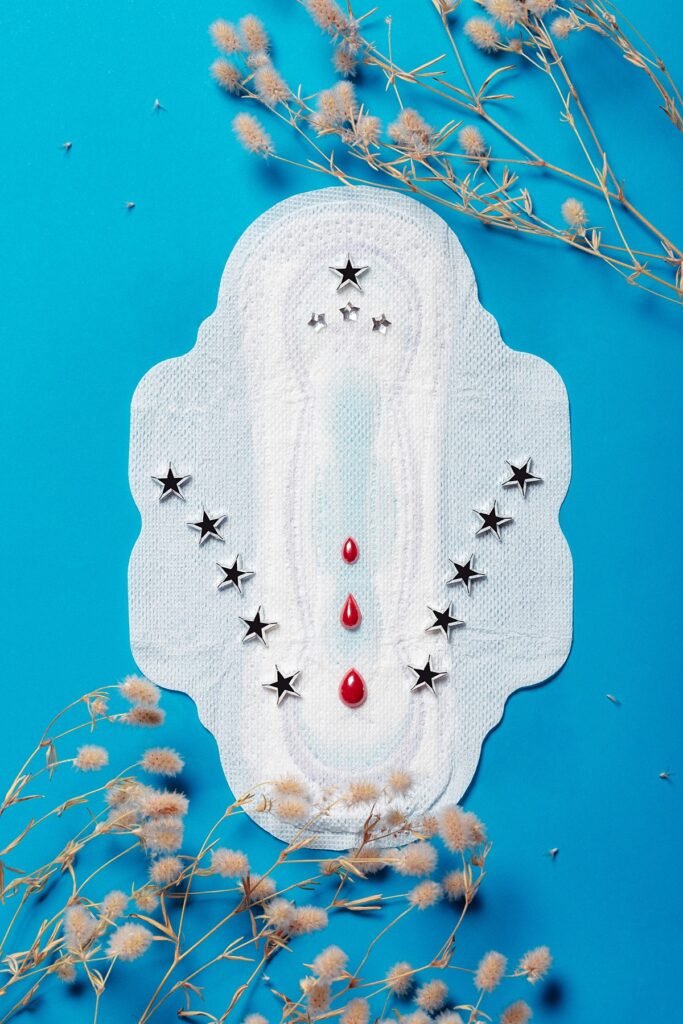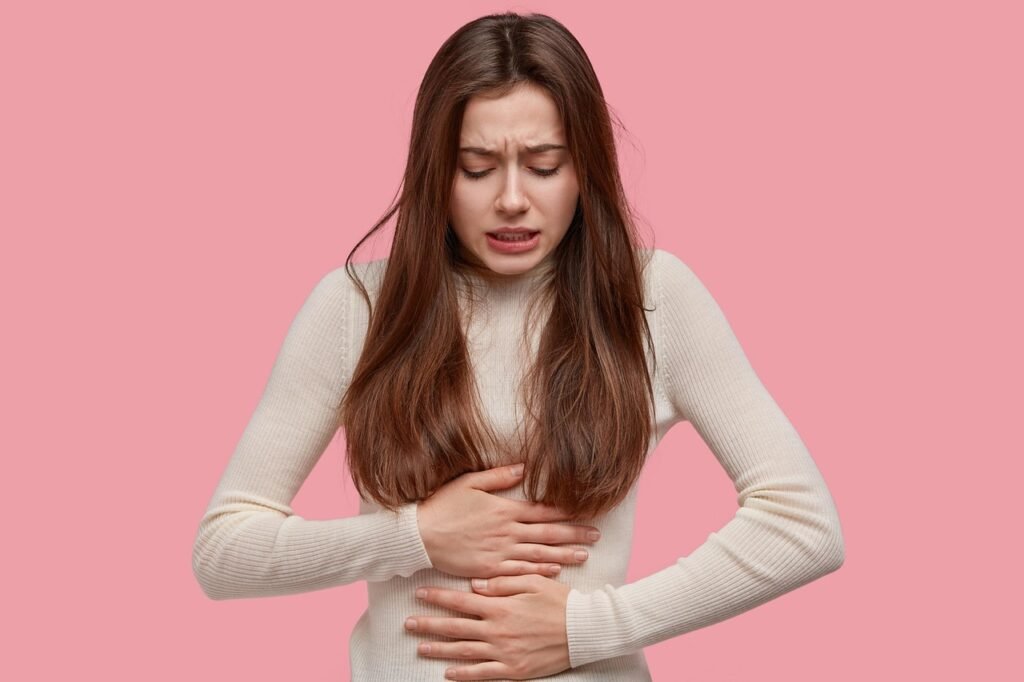Some days, you may feel full of euphoric happiness, like everything is going your way, and you feel ready to conquer the toughest obstacles. Other days, your clothes scratchy, your partner on your last nerve, and you swing between sorrow and rage at the smallest provocation. For people without ovaries, it may sound over the top, but for many of us, it’s just another month. The infamous stage called PMS affects over 90 percent of women, causing uncomfortable symptoms, according to the Office on Women’s Health (OWH). Beyond the PMS symptoms and endless countless jokes, our hormones deeply influence our emotions and behavior through the follicular phase, ovulatory phase, and luteal phase, as explained by the Cleveland Clinic.
If you’ve ever dealt with mood swings, cramps, or trouble sleeping before your period, you’re not alone. No two cycles are exactly alike, and it’s normal to feel different in the week leading up to your period. Some are even diagnosed with premenstrual syndrome (PMS), a catch-all term for how the cycle affects moods. To understand how moods and the cycle are linked, let’s dive into the lowdown of the menstrual process — a journey the body repeats each month to prepare for prospective pregnancy, starting from a fresh cycle on the first day of a new period and concludes the day before the following period, moving through four phases. The monthly cycle can cause a sparkle of exuberant happiness or leave you struggling to feel prepared for difficult challenges, with emotions swaying between nerves, alternate feelings of sadness, and slightest provocation. It all ties back to hormones and their direct cause and effect relationship: how hormones fluctuate once the period starts. Here’s a closer look at the hormonal changes shaping your mood.
Feeling Good: The Follicular Phase

The follicular phase of the menstrual cycle starts with the period and typically lasts around 10 days to 14 days, according to the Cleveland Clinic. During this time, the body releases follicle-stimulating hormone (FSH), which plays a role in stimulating the production of follicles in the ovaries, each holding tiny eggs. As explained by StatPearls, estradiol, a potent type of estrogen, also rises. This shift helps many women feel energized, sociable, clear minded, and happy. Dr. Taylor Hahn, MD, an ob-gyn at HerMD, points out that serotonin, a neurotransmitter linked to good mood and emotions, also increases, often making it easier to focus on progress at work or with school projects.
Around the same time, interest in exercise and physical activity can grow stronger. Research from Brain Sciences shows that women tend to experience more positive emotions and fewer moments of anger during the late follicular phase. With so many happy feelings rising, it’s no surprise that this phase is a fan favorite. All of these natural shifts in the cycle support the body not only for daily activities but also in preparing for possible pregnancy.
Feeling Frisky: The Ovulatory Phase

As ovulation begins, estrogen levels reach their peak, explains Cernadas. The luteinizing hormone (LH) rises around the 13th day of the cycle, as mentioned by StatPearls, telling the ovaries to release an egg into the fallopian tube to travel toward the uterus and get fertilized. According to the Cleveland Clinic, high estrogen levels and the impending egg release often cause women to experience strong feelings of happiness, attractiveness, and sexual desirability during this phase. Research points out that testosterone also rises during the ovulatory phase, boosting an improved mood and more energy, as observed by Hahn.
At this time, sex drive and desire may increase, and many experts believe this timing has a biological basis to naturally encourage sexual activity, boosting the likelihood of pregnancy. The body seems designed to make the most of this vibrant energy, making the ovulatory days some of the most exciting in the whole cycle. Feeling connected, confident, and ready to engage socially or intimately is a natural part of this fascinating rhythm.
Feeling Crappy: The Luteal Phase

After you ovulate, the follicle left behind by the departing egg secretes progesterone, an important hormone that prepares the uterus for a fertilized egg. This rise in progesterone can temporarily improve sleep and lower anxiety, but it may also bring unwanted side effects like bloating, constipation, fatigue, and fluid retention, says Kahn. Many notice stronger cravings for junk food and develop less-nutritional dietary habits during this time. If the egg remains unfertilized, progesterone levels fall, which according to the Cleveland Clinic, leads to a drop in other hormones like estradiol and testosterone, reaching their lowest point.
As hormone levels decrease, PMS symptoms often kick in. These can include cramps, increased acne, breast tenderness, and headaches, making the days before your next cycle challenging. Understanding this natural process can help manage expectations and give more compassion toward mood swings and physical discomfort during the luteal phase.
PMS Mood Swings
As the hormone dip happens during the luteal phase, emotions can start to feel like an emotional roller coaster. These shifts often show up through different symptoms such as libido changes, sudden feelings of anxiety, deep sadness, or even moments of depression. Some people may find it harder to think clearly, facing difficulty concentrating on daily tasks. Small changes like a change in appetite or trouble sleeping with insomnia are also very common signs that the body is adjusting to lower hormone levels.
During this time, it can feel frustrating when mood and energy levels swing unpredictably. Recognizing these natural changes makes it easier to show yourself patience and care. Everyone experiences the luteal phase a little differently, but being aware of hormone dip effects can help you better manage both the mental and physical challenges before your next period starts.
What Causes PMS?
Many experts believe that PMS symptoms are influenced by changes in serotonin, a chemical neurotransmitter that helps the brain and body regulate mood. A study showed that serotonin levels dip during the luteal phase, which may trigger common PMS symptoms. Another important factor is cortisol, the stress hormone. A cortisol rise is linked to emotional fluctuations, says Cernadas, and research in the International Journal of Molecular Sciences connects cortisol with weight gain, flushing, and fatigue.
Besides hormones, lifestyle habits are seen as worsening factors for symptom intensity. Kahn points out that women who smoked reported more mental health symptoms, while a poor diet high in fat, sugar, and salt increased physical symptoms. These different influences show how sensitive the body can be during this time, and how small changes in habits or stress levels can have a big effect on emotional and physical health.
Ways to Manage PMS
Experiencing PMS symptoms doesn’t always mean something is wrong, says Kahn. Many people with menstrual cycles notice changes, but the severity and how they manage symptoms can vary. For mild PMS symptoms, Hahn recommends making sleep a priority to help the body and mind rest, repair, and re-energize, especially when daytime fatigue becomes a major issue. Aiming for eight hours each night can make a difference. Focusing on a balanced diet and avoiding cravings for junk food or high-sugar sweets can also help, since they tend to worsen symptoms like bloating, nausea, and cramping. Choosing smaller meals or frequent meals with healthier meals throughout the day may lessen discomfort.
Gentle low-impact activity such as exercise or simple movement can boost endorphins, which improve mood and stabilize mood, while also helping to tamper food cravings, decrease pain, and decrease discomfort. Activities like walking or stretching in the living room are great starting points. For more serious premenstrual symptoms that resemble premenstrual dysphoric disorder, marked by severe symptoms like irritability, anxiety, or depression, reaching out to trusted sources like the OWH is important. Women experience hormonal changes that can shift hormone levels, leading to natural behavior changes throughout the menstrual cycle. A healthcare provider can guide you on how best to address symptoms based on your unique needs.
Key Takeaways on Period Cycle and Mood
- The menstrual cycle is made up of two phases: the follicular phase and the luteal phase.
- It starts on the first day of your period and is known as the start of cycle.
- You ovulate when the ovary releases an egg, marking the shift into ovulation and then the second part of cycle.
- The new period begins after the luteal phase ends.
- Even though no two cycles are the same, common emotional patterns happen during different stages.
- Many experience heightened emotions and mood swings due to changes in hormone levels.
- It’s normal to feel happier before ovulation and lower in mood during the week running up to period.
- Tracking changes in how you feel using an app like Flo can help identify trends.
- Keeping a record allows you to spot patterns and share important information with your doctor.
Understanding Menstrual Cycle Phases
Understanding the different phases of the menstrual cycle helps you track the natural process your body goes through each month during the preparation for a potential pregnancy. A new cycle begins on the first day of your new period and continues until the next period. Since all bodies are unique and no two are exactly the same, your experience may vary. While the average length of a cycle is around 28 days, anything between 21 days and 35 days is considered normal. The cycle is usually split into phases, starting with the follicular phase, which is the first part of the cycle. If you have an average cycle, the follicular phase typically covers about 14 days.
Around the time of ovulation, even though it’s not own phase, a big event happens when one of your ovaries releases an egg to be fertilized by sperm. After you have ovulated, the luteal phase begins, which is known as the second phase. This phase continues until the day before next period and is when the body either prepares for pregnancy or gears up for a new cycle. Knowing these signs can make it easier to spot where you are in your menstrual rhythm naturally.
Tracking Your Cycle and Understanding Hormones
If you don’t track your cycle, it can be hard to know where you are on any given day, especially since no two cycles are the same and the length of menstrual cycle can change month to month. Using a cycle-tracking app like Flo makes it easier to figure out phase by asking you to log first day and log last day of your period. Thanks to its clever technology, Flo can predict cycle patterns, along with changes in feeling and symptoms. If you prefer, you can also track with a pen and paper calendar. You can learn more about different ways to monitor your cycle and what they reveal about your body.
Hormones play a crucial role in triggering phases and controlling important processes both emotionally and physically. By knowing typical for you, it becomes easier to identify cycle stages, understand signs of ovulation, and notice premenstrual symptoms. How you feel differently at different points of the cycle offers helpful clues about what’s happening inside. Taking time to dig deeper into your patterns can make your menstrual journey feel less confusing and more empowering.
Your follicular phase and changes in your moods
During the first phase of the cycle, known as the follicular phase, your body starts to experience a shift in hormones. This is when follicle-stimulating hormone (FSH) becomes more active, and FSH levels begin to rise, stimulating the small fluid-filled sacs in your ovaries called follicles. These follicles are responsible for helping an egg develop and nurture for ovulation. As this happens, estrogen and estrogen levels also rise, leading to changes inside the uterus. The lining of the uterus starts thickening, all as part of preparing the body for a potential pregnancy. Each step plays a key role in setting up your hormonal environment for the next phase.
Personally, I’ve noticed that when higher estrogen levels occur, there’s a big difference in mood. Research shows that estrogen is linked to the production of a mood-boosting hormone called serotonin, and that’s why during the follicular phase, it’s common to feel happier and more energized. With the higher boost of estrogen, people often experience a positive mood, making the days leading up to ovulation feel lighter and more balanced.
Your luteal phase and changes in your moods
After ovulation, you move into your luteal phase, where important changes happen inside your body. Your estrogen levels start to drop while your progesterone levels rise. These hormones help to prepare the lining of the uterus in case you become pregnant during this cycle. If a fertilized egg forms, it will travel through the uterine tube and implant itself into the wall of the uterus. The uterine lining continues to develop and thicken to support the possible implantation. If you don’t conceive, your body will break down the uterine lining, causing it to leave your body as a period.
I’ve noticed from personal experience that high levels of estrogen can make me feel good because they are linked to the production of the happy hormone called serotonin. But when there are lower levels of estrogen, I start to feel more irritable or even sad. It’s all part of how powerful hormone changes are during each phase of the cycle, shaping not just the body but also the mood.
Premenstrual symptoms and premenstrual syndrome (PMS)
A change in mood is often one of the first signs that your period is coming. In the days before it arrives, many people notice premenstrual symptoms that affect how they feel physically and emotionally. The term PMS is used to describe a group of physical symptoms and emotional symptoms that often repeat with each cycle. Even without an official diagnosis, it’s easy to recognize common PMS symptoms like feeling upset, anxious, or irritable, and to notice how much they impact everyday life. Through personal experience, I know how hard it can be, and some people even get diagnosed with more severe forms of PMS.
Some of the typical common PMS symptoms include tiredness, bloating, headaches, changes in appetite, shifts in sex drive, and painful cramps. These symptoms can create serious mood swings that make you feel like you are on an emotional rollercoaster. Recognizing these patterns helps in managing them better and reminds us that these shifts are a natural part of the cycle.
Premenstrual dysphoric disorder (PMDD)
While premenstrual symptoms and PMS are common, some people experience a more intense condition called premenstrual dysphoric disorder (PMDD). PMDD is much rarer and is considered a severe form of PMS. It can bring extreme sadness, anxiety, mood swings, and anger that may seriously disrupt your daily life and impact your relationships. From personal experience, it’s important to know that doctors still don’t fully understand the cause of PMDD, but there are treatments that can help. Often, they will prescribe medication, recommend stress management techniques such as mindfulness, or suggest changes to your lifestyle.
If you think you might have PMDD, never hesitate to seek support from a health care provider. They can guide you better and may even provide a list of helplines that can be really useful. Reaching out early can make managing the emotional and physical struggles of PMDD much easier over time.
How to manage the highs and lows of the menstrual cycle
The hormonal changes during your cycle can sometimes make you feel like you’re on an emotional roller coaster. It’s normal to feel overwhelmed when moods swing so quickly. One way I manage these ups and downs is by getting regular exercise, like joining a gym class that I actually enjoy, or setting a schedule for a weekly walk with a friend. Eating a balanced diet by filling up plate with veggies, protein, and good fats also helps balance energy levels. Another important habit is getting enough sleep every night, even though it’s easier said than done on busy days.
Besides physical care, emotional support is key. I always try to connect with friends and family, remembering that we are social beings who benefit from speaking openly with loved ones. Sharing when you’re not in a good mood can make you feel better and strengthen your support network. You don’t have to be perfect; every small step is a big win when it comes to taking care of yourself during your cycle.
Understanding the Menstrual Cycle
The menstrual cycle is controlled by key sex hormones like estrogen and progesterone, and their hormone levels constantly fluctuate throughout the month. In the first half of the cycle, oestrogen levels are growing and peaking around ovulation, while in the second half, progesterone levels start increasing until right before the period starts. During the first phase, called the follicular phase, the follicle that holds the egg or ovum grows. After ovulation, the second phase, known as the luteal phase, begins. Here, the egg discharged from the follicle, and the follicle develops into a corpus luteum, which generates both progesterone and estrogen to support the body in case of pregnancy.
From my personal experience, the constant fluctuation in hormones can really affect how you feel, both physically and emotionally. The balance of these hormones can have a powerful impact on your mood, making some days feel calm and others much more challenging. Understanding these changes has helped me better listen to my body and take care of myself during every part of the cycle.
What Stage of the Menstrual Cycle Are You Currently In?
One of the easiest ways to find out which phase you are in is by tracking your cycle carefully. You can keep a cycle calendar and note when your period begins and when your period ends, along with your flow and any symptoms you experience. Many people prefer using an app to monitor cycle changes automatically. Paying attention to menstrual flow, duration, and characteristics like bleeding patterns can help you identify menstrual cycle stages more clearly. You can also measure cycle length by counting days from the first day of one period to the next period, which gives a better idea of your body’s timing.
Another method includes monitoring ovulation by watching for changes in cervical mucus—it becomes clearer and stretchier around ovulation. Tools like an ovulation predictor kit can detect hormone levels in your urine. You might also try tracking basal body temperature; take your temperature waking up each morning and notice a modest rise after ovulation. Watching your vaginal discharge can give clues too: it feels discharge moist, slippery like egg whites during ovulation, and turns discharge thick, dry, and paste-like in the luteal phase. Based on my experience, combining these signs makes it much easier to truly understand what your body is telling you each month.
Your Most Fertile Phase to Start Trying for Pregnancy
If you are planning to get pregnant, it’s important to know that the luteal phase is when the body prepares for pregnancy and can be a useful sign of your fertility. A long luteal phase or a short luteal phase may affect your chances, especially if you do not ovulate regularly. In my experience, it’s wise to consult a doctor who can diagnose any medical issues that may be impacting your ovulatory cycle. They might recommend specific treatment options based on your body’s needs.
If you are under 35 and have been trying to conceive for at least a year without success, it’s important to schedule appointment with your primary care physician or see a reproductive specialist. You may be facing a treatable fertility issue. However, if you are 35 or older, it’s better to call doctor after 6 months of trying to get the right support early. Trust me, getting help sooner rather than later can make a big difference in your journey to parenthood.
Changes in Mood During the 4 Stages of Menstrual Cycle
Since everyone is unique, the way hormonal changes impact emotions can happen differently for each of us. Some women feel better right at the start of their menstrual cycle, while others require a little longer to feel substantially better. There are cases where an immediate difference is noticed once periods begin, but some people need to wait a few days for estrogen’s mood-enhancing effects to kick in. Based on my personal experience, it’s comforting to know that mood shifts don’t always follow a strict pattern for everyone.
Others may report feeling not so great through the whole cycle, which makes it crucial to understand that not everyone experiences PMS or has the same symptoms. The highs and lows tied to the different phases remind us how complex and personal the menstrual cycle journey really is. Acknowledging these patterns helps women respond more kindly to their bodies and emotions throughout the month.
Hormone Levels During The 4 Phases of Menstrual Cycle
Many women feel great during or right after their menstrual cycle, and if you do too, you are not alone. This usually happens because of hormonal changes that occur at different times in the cycle. When hormonal levels rise in the follicular phase, it often helps to improve your mood. From my experience, understanding the timing of these shifts made a huge difference in how I prepare for each month. But it’s important to notice the contrast too — as alterations in levels of progesterone and oestrogen later on can bring an opposite impact on how we feel.
Taking a closer look at hormone changes during each time of the cycle helps explain the emotional ups and downs. As hormonal changes occur, they impact both the body and mind differently. This knowledge has helped me recognize when to slow down and when to lean into feeling more energized. Everyone’s journey with hormone shifts is unique, but knowing the basic pattern can make managing moods so much easier.
The Four Stages of Menstrual Cycle & The Role of Hormones in it:
1. The Follicular Phase (A Mood Enhancer)
During the follicular phase, many women notice their mood lighter and enjoy more energy. This phase usually lasts about two weeks before ovulation. Day 1 of the follicular phase begins with menstruation, when estrogen levels are low at the start of the period, but they quickly rise as the follicular period continues to develop. Estrogen, along with the follicle-stimulating hormone (FSH), helps grow the follicle that holds the egg and works to thicken the uterine lining in preparation for a possible implantation of a fertilized egg. As your PMS symptoms like irritability and poor mood begin to subside with the ending of periods, you usually feel happier and more social.
One reason for this positive change is that estrogen is closely tied to serotonin, a powerful neurotransmitter that regulates mood. When synthesis of serotonin increases, it promotes feelings of happiness and contentment. Throughout this phase, progesterone levels stay fairly steady and modest until they start rising in the luteal phase after ovulation. Understanding these hormonal fluctuations can really help you better manage your mental health and recognize why you feel your best during this time.
2. The Ovulatory Phase (Middle of Your Menstrual Cycle)
In the middle of the menstrual cycle, a special event called ovulation happens when the ovary releases egg to prepare for a possible pregnancy. During this time, estrogen levels rise in a very sudden and significant way, along with an increase in luteinizing hormone (LH), which triggers the egg’s release. In my own experience, this part of the cycle often feels like a burst of energy, but it also brings quick shifts in emotions depending on how the hormones move.
Some women, including myself, may notice low moods right after the estrogen levels fall from their pre-ovulation peak. However, these feelings are usually fleeting because hormone levels rise again shortly after. Knowing this pattern makes it easier to understand why your mood can swing quickly around ovulation and reminds you that it’s just another natural rhythm of your cycle.
3. Luteal Phase (Feeling of Calm)
After ovulation, something amazing happens inside the body. The corpus luteum forms in the ovary and generates progesterone to support the next steps. During the luteal phase, which covers the remainder of the cycle until the next period, progesterone levels rise steadily. In my experience, the first half of the luteal phase feels like a time when the body prepares for a possible pregnancy, helping you feel more balanced and centered.
As the progesterone levels rise, many women start to feel relaxed and even sleep better. This is because calming chemicals in the brain are triggered, making this phase one of emotional steadiness compared to the ups and downs of earlier stages. Personally, recognizing these natural shifts has helped me work with my body’s rhythm instead of fighting against it.
4. Menstruation (Sadness and Low Mood)
As you approach menstruation, it’s very common to feel a sense of calm start to shift. When menstruation begins, the period officially starts, and the body releases uterine blood and tissue through the vagina. In this phase, if there is no HCG (Human Chorionic Gonadotropin, also called the pregnancy hormone) to prevent the corpus luteum from making progesterone, the corpus luteum begins to deteriorate. This leads to a decrease in both estrogen and progesterone levels, which is completely normal if pregnancy hasn’t occurred.
As hormone levels drop, serotonin levels also fall, and because serotonin plays a big role in happiness, it’s common to experience a poor mood and even depressive symptoms. These emotional changes can feel like moderate variations in motivation, mood, and energy, but it’s important to remember that these shifts are a normal part of the menstrual cycle. Personally, understanding these patterns has helped me better support my body during these tougher days.
FAQ’S
Does Your Menstrual Cycle Affect Your Mood?
No two cycles are the same, and it’s normal to feel different because of heightened emotions or mood swings at different points. These shifts happen due to changes in your hormone levels, making you feel happier just before ovulation and lower in the week running up to your period.
Which Menstrual Phase Is Best for Your Mood?
After menstruation, the follicular phase begins, and this phase typically lasts seven to 14 days, marked by rising levels of oestrogen that lead to feelings of energy and positivity.
When Is Mood Lowest in the Cycle?
After post-ovulation, the body enters the luteal phase, where oestrogen levels begin to fall and progesterone rises steadily. For most women, this becomes the problematic part of the cycle, often marked by feelings of tiredness and emotional sensitivity.
When Are Females More Emotional During the Menstrual Cycle?
Many women notice feeling sad or even crying, and it’s very common before period and during period. The main cause behind this emotional shift is hormonal changes that happen naturally during menstruation and ovulation.

Emily Harper is a board-certified nurse practitioner and certified obesity medicine specialist with a strong clinical background in metabolic health and GLP-1 therapies. With years of frontline experience managing patients on Ozempic, she brings both scientific knowledge and real-world insight to her writing.




